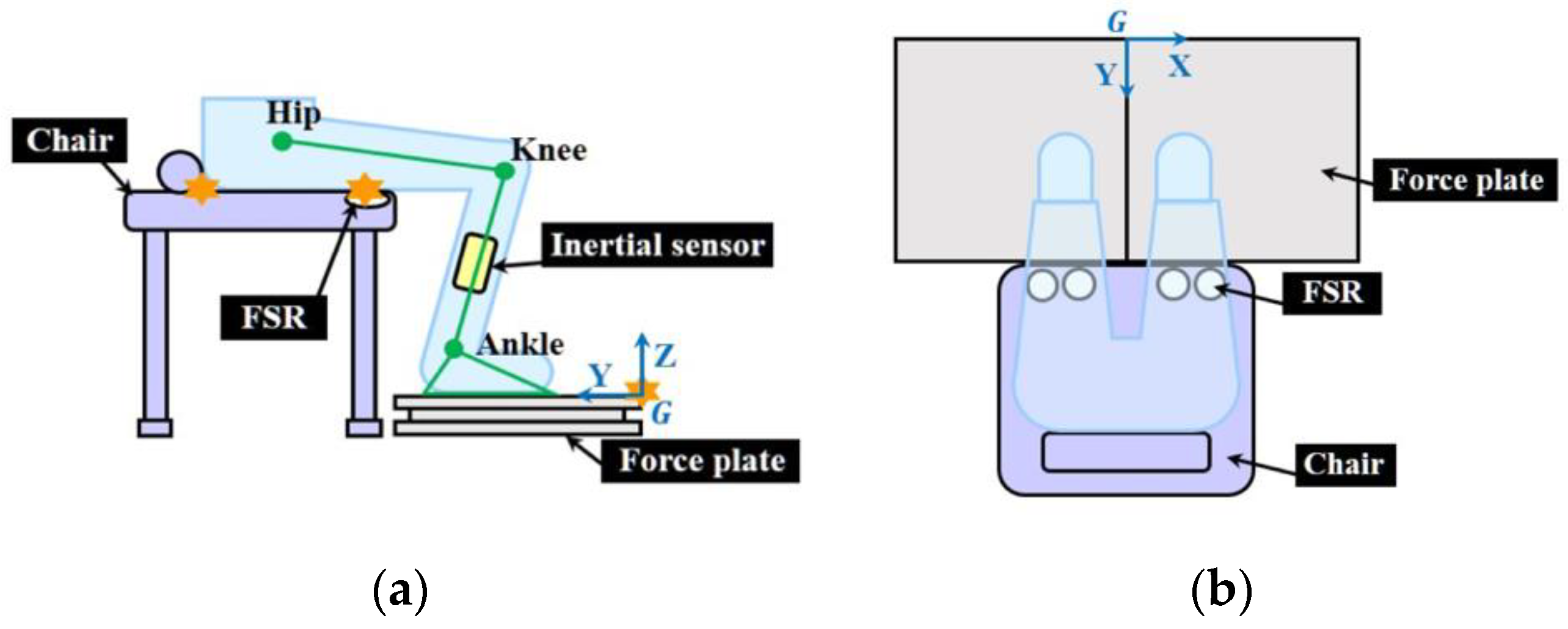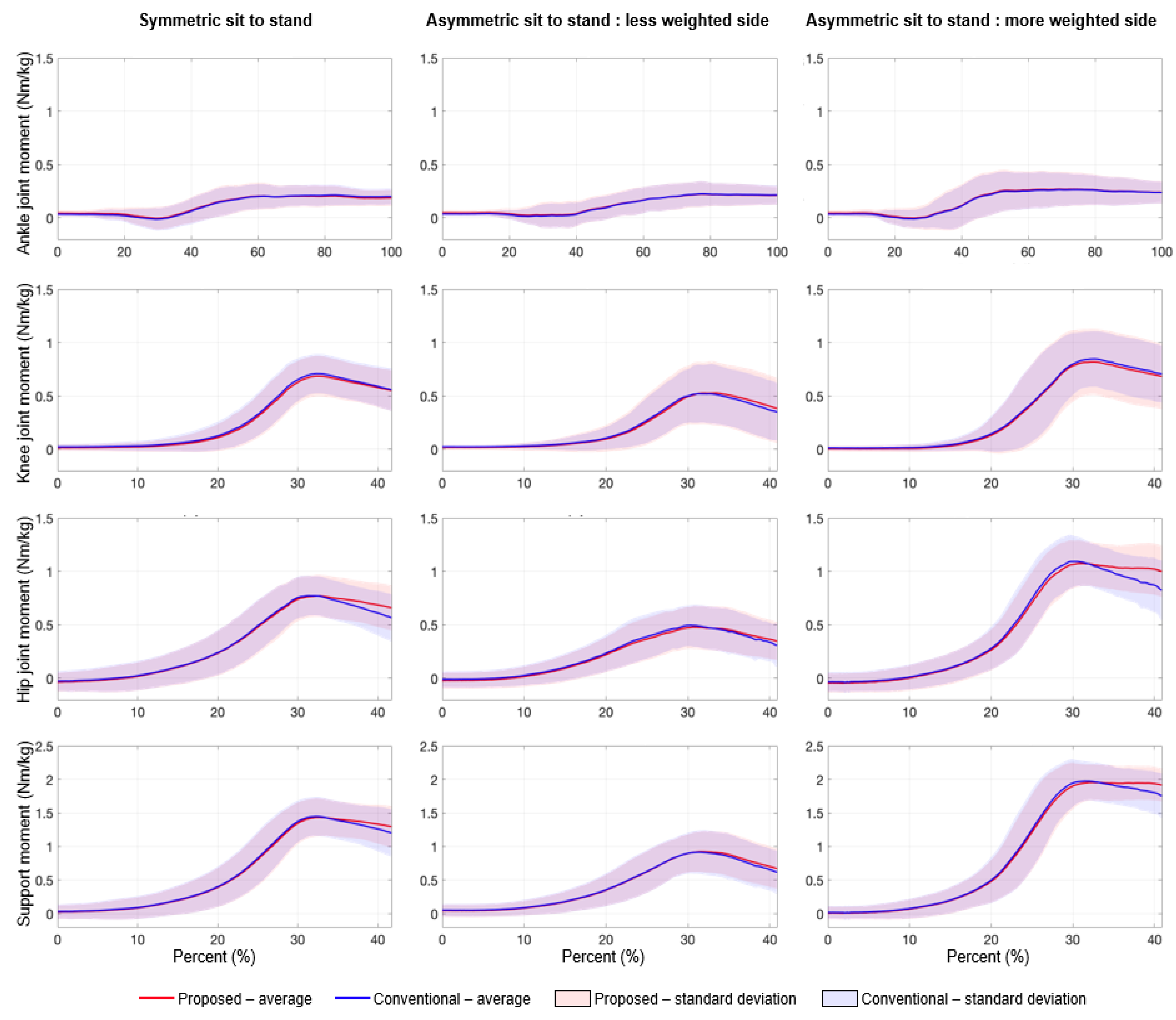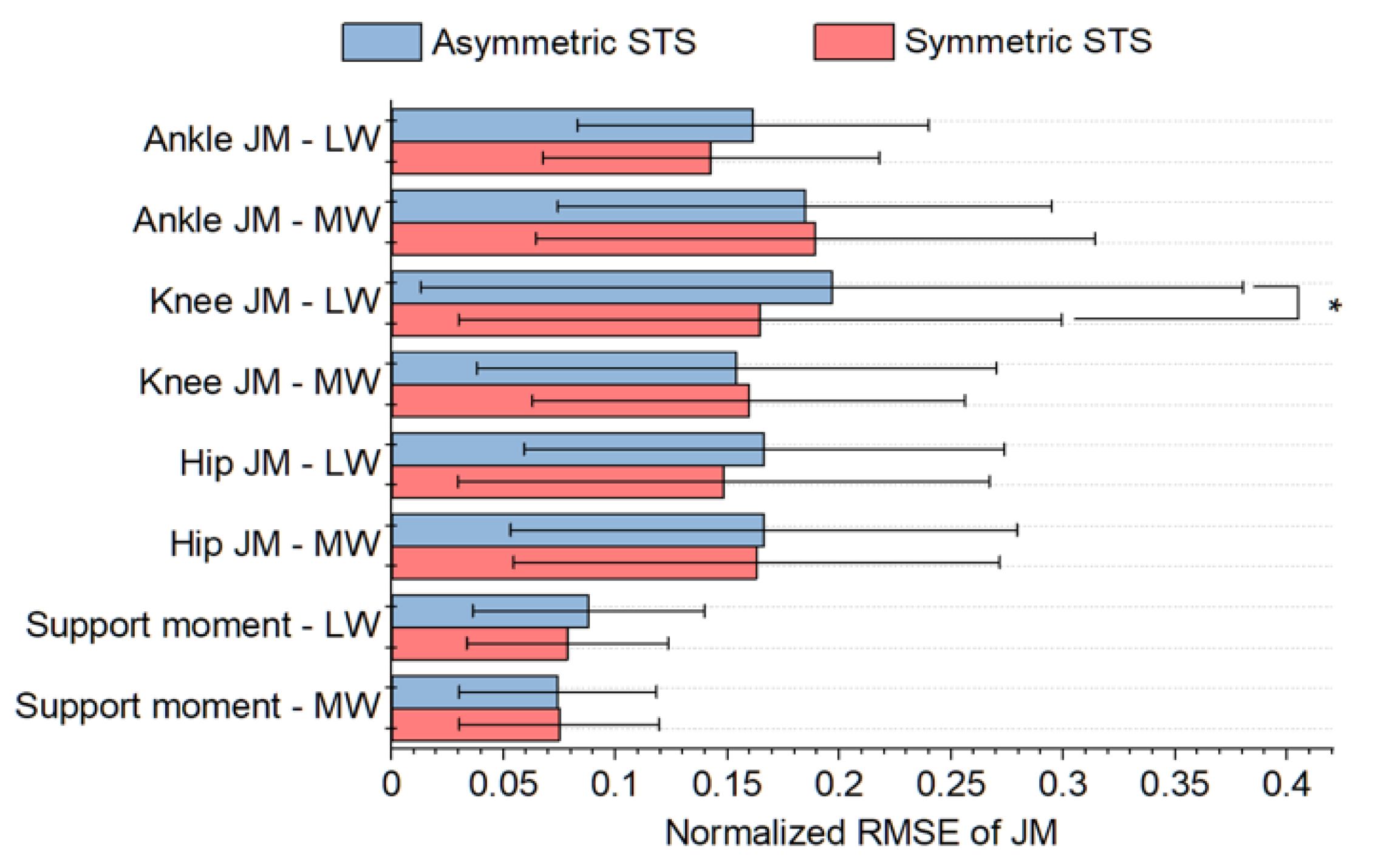A Novel Simplified System to Estimate Lower-Limb Joint Moments during Sit-to-Stand
Abstract
1. Introduction
2. Methods
2.1. Kinematic Model of Sit-to-Stand
2.1.1. Segment Angle Calculation While Sitting
2.1.2. Shank Angle Calculating after Sitting
2.1.3. Thigh Angle Calculation After Sitting
2.2. Inverse Dynamics
3. Experiments
3.1. Experimental Design
3.2. Protocols
3.3. Data Analysis
4. Results
4.1. Estimation of Joint Moments
4.2. Estimation of Other Sit-to-Stand Outcomes
4.3. Estimation of Segment Angles
5. Discussion
6. Conclusions
Author Contributions
Funding
Institutional Review Board Statement
Informed Consent Statement
Data Availability Statement
Conflicts of Interest
References
- Cippitelli, E.; Gasparrini, S.; Spinsante, S.; Gambi, E.; Verdini, F.; Burattini, L.; Di Nardo, F.; Fioretti, S. Validation of an Optimized Algorithm to Use Kinect in a Non-Structured Environment for Sit-to-Stand Analysis. In Proceedings of the EMBC 2015—2015 27th Annual International Conference of the IEEE Engineering in Medicine and Biology Society, Milan, Italy, 25–29 August 2015; Institute of Electrical and Electronics Engineers (IEEE): Piscataway, NJ, USA, 2015; pp. 5078–5081. [Google Scholar]
- Bonnet, V.; Azevedo-Coste, C.; Robert, T.; Fraisse, P.; Venture, G. Optimal External Wrench Distribution During a Multi-Contact Sit-to-Stand Task. IEEE Trans. Neural Syst. Rehabil. Eng. 2017, 25, 987–997. [Google Scholar] [CrossRef] [PubMed]
- Roy, G.; Nadeau, S.; Gravel, D.; Piotte, F.; Malouin, F.; McFadyen, B.J. Side difference in the hip and knee joint moments during sit-to-stand and stand-to-sit tasks in individuals with hemiparesis. Clin. Biomech. 2007, 22, 795–804. [Google Scholar]
- Nadeau, S.; Desjardins, P.; Brière, A.; Roy, G.; Gravel, D. A chair with a platform setup to measure the forces under each thigh when sitting, rising from a chair and sitting down. Med. Biol. Eng. Comput. 2008, 46, 299–306. [Google Scholar] [CrossRef]
- Mao, Y.R.; Wu, X.Q.; Zhao, J.L.; Lo, W.L.A.; Chen, L.; Ding, M.H.; Xu, Z.Q.; Bian, R.H.; Huang, D.F.; Li, L. The Crucial Changes of Sit-to-Stand Phases in Subacute Stroke Survivors Identified by Movement Decomposition Analysis. Front. Neurol. 2018, 9, 1–8. [Google Scholar]
- Martínez-Ramírez, A.; Weenk, D.; Lecumberri, P.; Verdonschot, N.; Pakvis, D.; Veltink, P.H. Assessment of asymmetric leg loading before and after total hip arthroplasty using instrumented shoes. J. Neuroeng. Rehabil. 2014, 11, 1–9. [Google Scholar]
- Lundin, T.M.; Grabiner, M.D.; Jahnigen, D.W. On the assumption of bilateral lower extremity joint moment symmetry during the sit-to-stand task. J. Biomech. 1995, 28, 109–112. [Google Scholar]
- Boukadida, A.; Piotte, F.; Dehail, P.; Nadeau, S. Determinants of sit-to-stand tasks in individuals with hemiparesis post stroke: A review. Ann. Phys. Rehabil. Med. 2015, 58, 167–172. [Google Scholar]
- Yang, N.; An, Q.; Kogami, H.; Yamakawa, H.; Tamura, Y.; Takahashi, K.; Kinomoto, M.; Yamasaki, H.; Itkonen, M.; Shibata-Alnajjar, F.; et al. Temporal Features of Muscle Synergies in Sit-to-Stand Motion Reflect the Motor Impairment of Post-Stroke Patients. IEEE Trans. Neural Syst. Rehabil. Eng. 2019, 27, 2118–2127. [Google Scholar]
- Abujaber, S.; Pozzi, F.; Zeni, J., Jr. Influence of weight bearing visual feedback on movement symmetry during sit to stand task. Clin. Biomech. 2017, 47, 110–116. [Google Scholar]
- Martínez-Ramírez, A.; Weenk, D.; Lecumberri, P.; Verdonschot, N.; Pakvis, D.; Veltink, P.H. Preoperative Ambulatory Measurement of Asymmetric Leg Loading During Sit-to-Stand in Hip Arthroplasty Patients. IEEE Trans. Neural Syst. Rehabil. Eng. 2014, 22, 585–592. [Google Scholar]
- Kneiss, J.A.; Hilton, T.N.; Tome, J.; Houck, J.R. Weight-bearing asymmetry in individuals post-hip fracture during the sit to stand task. Clin. Biomech. 2015, 3, 14–21. [Google Scholar] [CrossRef] [PubMed]
- Abujaber, S.; Gillispie, G.; Marmon, A.; Zeni, J., Jr. Validity of the Nintendo Wii Balance Board to assess weight bearing asymmetry during sit-to-stand and return-to-sit task. Gait Posture 2015, 41, 676–682. [Google Scholar] [CrossRef] [PubMed]
- Chorin, F.; Cornu, C.; Beaune, B.; Frère, J.; Rahmani, A. Sit to stand in elderly fallers vs. non-fallers: New insights from force platform and electromyography data. Aging Clin. Exp. Res. 2016, 28, 871–879. [Google Scholar] [CrossRef] [PubMed]
- Winter, D.A. Biomechanics and Motor Control of Human Movement, 4th ed.; Wiley: Hoboken, NJ, USA, 2009; pp. 83–125. [Google Scholar]
- Alnahdi, A.H.; Zeni, J.A.; Snyder-Mackler, L. Quadriceps strength asymmetry predicts loading asymmetry during sit-to-stand task in patients with unilateral total knee arthroplasty. Knee Surg. Sports Traumatol. Arthrosc. 2016, 24, 2587–2594. [Google Scholar] [PubMed]
- Šlajpah, S.; Kamnik, R.; Burger, H.; Bajd, T.; Munih, M. Asymmetry in sit-to-stand movement in patients following transtibial amputation and healthy individuals. Int. J. Rehabil. Res. 2013, 26, 275–283. [Google Scholar]
- Christiansen, C.L.; Bade, M.J.; Davidson, B.S.; Dayton, M.R.; Stevens-Lapsley, J.E. Effects of Weight-Bearing Biofeedback Training on Functional Movement Patterns Following Total Knee Arthroplasty: A Randomized Controlled Trial. J. Orthop. Sports Phys. Ther. 2015, 45, 647–655. [Google Scholar]
- Zeni Jr., J.; Abujaber, S.; Flowers, P.; Pozzi, F.; Snyder-Mackler, L. Biofeedback to promote movement symmetry after total knee arthroplasty: A feasibility study. J. Orthop. Sports Phys. Ther. 2013, 43, 715–726. [Google Scholar]
- Varin, D.; Lamontagne, M.; Beaulé, P.E. Does Symmetry of Lower Limb Kinetics Exist in Sitting and Standing Tasks? In Proceedings of the ISBS 2011—29th Conference of the International Society of Biomechanics in Sports, Porto, Portugal, 27 June–1 July 2011; pp. 571–574. [Google Scholar]
- Lamontagne, M.; Beaulieu, M.L.; Varin, D.; Beaulé, P.E. Lower-Limb Joint Mechanics after Total Hip Arthroplasty during Sitting and Standing Tasks. J. Orthop. Res. 2012, 30, 1611–1617. [Google Scholar] [CrossRef]
- Yoshioka, S.; Nagano, A.; Hay, D.C.; Tabata, I.; Isaka, T.; Iemitsu, M.; Fukashiro, S. New Method of Evaluating Muscular Strength of Lower Limb Using MEMS Acceleration and Gyro Sensors. J. Robot. Mechatron. 2013, 25, 153–161. [Google Scholar] [CrossRef]
- Kodama, J.; Watanabe, T. Examination of Inertial Sensor-Based Estimation Methods of Lower Limb Joint Moments and Ground Reaction Force: Results for Squat and Sit-to-Stand Movements in the Sagittal Plane. Sensors 2016, 16, 1–19. [Google Scholar]
- Hendershot, B.D.; Wolf, E.J. Persons with unilateral transfemoral amputation have altered lumbosacral kinetics during sitting and standing movements. Gait Posture 2015, 42, 204–209. [Google Scholar] [CrossRef] [PubMed]
- Liu, K.; Yan, J.; Liu, Y.; Ye, M. Noninvasive Estimation of Joint Moments with Inertial Sensor System for Analysis of STS Rehabilitation Training. J. Healthc. Eng. 2018, 2018, 1–15. [Google Scholar] [CrossRef]
- Matthew, R.P.; Seko, S.; Bailey, J.; Bajcsy, R.; Lotz, J. Estimating Sit-to-Stand Dynamics Using a Single Depth Camera. IEEE J. Biomed. Health 2019, 23, 2592–2602. [Google Scholar] [CrossRef] [PubMed]
- Foo, J.; Paterson, K.; Williams, G.; Clark, R. Low-cost evaluation and real-time feedback of static and dynamic weight bearing asymmetry in patients undergoing in-patient physiotheraphy rehabilitation for neurological conditions. J. Neuroeng. Rehabil. 2013, 10, 1–8. [Google Scholar] [CrossRef] [PubMed]
- Shukla, B.K.; Jain, H.; Vijay, V.; Yadav, S.K.; Mathur, A.; Hewson, D.J. A Comparison of Four Approaches to Evaluate the Sit-to-Stand Movement. IEEE Trans. Neural Syst. Rehabil. Eng. 2020, 28, 1317–1324. [Google Scholar] [CrossRef]
- Pai, Y.-C.; Rogers, M.W. Speed Variation and Resultant Joint Torques During Sit-to-Stand. Arch. Phys. Med. Rehabil. 1991, 72, 881–885. [Google Scholar] [CrossRef]
- Pal, A.R.; Pratihar, D.K. Estimation of Joint Torque and Power Consumption during Sit-to-Stand Motion of Human-being Using a Genetic Algorithm. Procedia Comput. Sci. 2016, 96, 1497–1506. [Google Scholar] [CrossRef]
- Yamasaki, H.R.; Kambara, H.; Koike, Y. Dynamic optimization of the sit-to-stand movement. J. Appl. Biomech. 2011, 27, 306–313. [Google Scholar] [CrossRef]
- Eitzen, I.; Fernandes, L.; Nordsletten, L.; Snyder-Macker, L.; Risberg, M.A. Weight-bearing asymmetries during Sit-To-Stand in patients with mild-to-moderate hip osteoarthritis. Gait Posture 2014, 39, 683–688. [Google Scholar] [CrossRef]
- Dos Santos, A.N.; Pena, G.M.; Guilherme, E.M.; Rocha, N.A.C.F. Asymmetry in children with unilateral cerebral palsy during sit-to-stand movement: Cross-sectional, repeated-measures and comparative study. Clin. Biomech. 2020, 71, 152–159. [Google Scholar] [CrossRef]
- Ferris, A.E.; Christiansen, C.L.; Heise, G.D.; Hahn, D.; Smith, J.D. Ertl and Non-Ertl amputees exhibit functional biomechanical differences during the sit-to-stand task. Clin. Biomech. 2017, 44, 1–6. [Google Scholar] [CrossRef] [PubMed]
- Hara, R.; McGinley, J.; Briggs, C.; Baker, R.; Sangeux, M. Predicting the location of the hip joint centres, impact of age group and sex. Sci. Rep. 2016, 6, 1–9. [Google Scholar]
- Fino, P.C.; Frames, C.W.; Lockhart, T.E. Classifying Step and Spin Turns Using Wireless Gyroscopes and Implications for Fall Risk Assessments. Sensors 2015, 15, 10676–10685. [Google Scholar] [CrossRef] [PubMed]
- An, J.; Lee, B. Reliability of joint angle during sit-to-stand movements in persons with stroke using portable gait analysis system based wearable sensors. Phys. Ther. Rehabil. Sci. 2019, 8, 146–151. [Google Scholar] [CrossRef]
- Agrawal, V.; Gailey, R.; Gaunaurd, I.; Gailey III, R.; O’Toole, C. Weight distribution symmetry during the sit-to-stand movement of unilateral transtibial amputees. Ergonomics 2011, 54, 656–664. [Google Scholar] [CrossRef] [PubMed]
- Craig, J.J. Introduction to Robotics: Mechanics and Control, 3rd ed.; Pearson Education: London, UK, 2009; pp. 109–216. [Google Scholar]
- Nuzik, S.; Lamb, R.; VanSant, A.; Hirt, S. Sit-to-stand movement pattern: A kinematic study. Phys. Ther. 1986, 66, 1708–1713. [Google Scholar] [CrossRef] [PubMed]
- Hwang, S.; Choi, S.; Kim, J. Toward clinically-relevant joint moment estimation during sit to stand: A feasibility study. In Proceedings of the EMBC 2019—2019 41st Annual International Conference of the IEEE Engineering in Medicine and Biology Society, Berlin, Germany, 23–27 July 2019; Institute of Electrical and Electronics Engineers (IEEE): Piscataway, NJ, USA, 2019; pp. 538–541. [Google Scholar]
- Wu, G.; Ladin, Z. Limitations of quasi-static estimation of human joint loading during locomotion. Med. Biol. Eng. Comput. 1996, 34, 472–476. [Google Scholar] [CrossRef] [PubMed]
- Yoshioka, S.; Nagano, A.; Hay, D.C.; Fukashiro, S. Biomechanical analysis of the relation between movement time and joint moment development during a sit-to-stand task. Biomed. Eng. Online 2009, 8, 1–9. [Google Scholar]
- Pertersen, J.; Sørensen, H.; Neilsen, R.Ø. Cumulative loads increase at the knee joint with slow-speed running compared to faster running: A biomechanical study. J. Orthop. Sports Phys. Ther. 2015, 45, 316–322. [Google Scholar] [CrossRef]
- Schenkman, M.; Riley, P.O.; Pieper, C. Sit to stand from progressively lower seat heights—Alterations in angular velocity. Clin. Biomech. 1996, 11, 153–158. [Google Scholar] [CrossRef]
- Rocha, A.D.S.; Knaben, R.J.; Michaelsen, S.M. Non-paretic lower limb constraint with a step decrease the asymmetry of vertical forces during sit-to-stand at two seat heights in subjects with hemiparesis. Gait Posture 2010, 32, 457–463. [Google Scholar]
- Kralj, A.; Jaeger, R.J.; Munih, M. Analysis of standing up and sitting down in humans: Definitions and normative data presentation. J. Biomech. 1990, 23, 1123–1138. [Google Scholar] [CrossRef]
- Matthew, R.P.; Seko, S.; Bajcsy, R.; Lotz, J. Kinematic and Kinetic Validation of an Improved Depth Camera Motion Assessment System Using Rigid Bodies. IEEE J. Biomed. Health 2019, 23, 1784–1793. [Google Scholar] [CrossRef] [PubMed]
- Hughes, M.A.; Weiner, D.K.; Schenkman, M.L.; Long, R.M.; Studenski, S.A. Chair rise strategies in the elderly. Clin. Biomech. 1994, 9, 187–192. [Google Scholar]
- Inkster, L.M.; Eng, J.J. Postural control during a sit-to-stand task in individuals with mild Parkinson’s disease. Exp. Brain Res. 2014, 154, 33–38. [Google Scholar] [CrossRef] [PubMed]
- Mak, M.K.Y.; Levin, O.; Mizrahi, J.; Hui-Chan, C.W.Y. Joint torques during sit-to-stand in healthy subjects and people with Parkinson’s disease. Clin. Biomech. 2003, 18, 197–206. [Google Scholar] [CrossRef]
- Musić, K.; Kamnik, R.; Munih, M. Model based inertial sensing of human body motion kinematics in sit-to-stand movement. Simul. Model. Pract. Theory 2008, 16, 933–944. [Google Scholar]
- Golestan, S.; Romero, D.J.D.; Stroulia, E.; Miguel-Cruz, A.; Liu, L. Sensor-enabled Functional-Mobility Assessment: An Exploratory Investigation. In Proceedings of the WF-IoF 2019-2019 IEEE 5th World Forum on Internet of Things (WF-IoT), Limrick, Ireland, 15–18 April 2019; Institute of Electrical and Electronics Engineers (IEEE): Piscataway, NJ, USA, 2019; pp. 195–200. [Google Scholar]






| Mean (Standard Deviation) | ||
|---|---|---|
| Age (years) | 27.563 (2.850) | |
| Height, H (m) | 1.676 (0.087) | |
| Weight, W (kg) | 63.588 (11.134) | |
| Leg length, L (m) | Left | 0.847 (0.062) |
| Right | 0.849 (0.061) | |
| Shank length, lshank (m) | Left | 0.379 (0.028) |
| Right | 0.380 (0.025) | |
| Thigh length, lthigh (m) | Left | 0.390 (0.020) |
| Right | 0.385 (0.037) |
| Models | Constants |
|---|---|
| Equation (2) | c1 = 0.137, c2 = −0.026, c3 = 0.252 |
| Equation (6) | c4 = 0.233, c5 = −0.00144, c6 = −0.175 |
| RMSE (Nm/kg) | CC (95% CI) | ||
|---|---|---|---|
| Ankle joint moment | Sym. | 0.026 ± 0.010 | 0.99 ± 0.01 (0.988–0.990) |
| LW | 0.024 ± 0.009 | 0.99 ± 0.01 (0.991–0.995) | |
| MW | 0.028 ± 0.010 | 0.99 ± 0.01 (0.992–0.996) | |
| Knee joint moment | Sym. | 0.067 ± 0.048 | 1.00 ± 0.01 (0.997–0.999) |
| LW | 0.041 ± 0.031 | 0.99 ± 0.02 (0.990–0.998) | |
| MW | 0.091 ± 0.058 | 1.00 ± 0.00 (0.999–0.999) | |
| Hip joint moment | Sym. | 0.068 ± 0.045 | 0.99 ± 0.01 (0.988–0.994) |
| LW | 0.044 ± 0.023 | 0.99 ± 0.01 (0.987–0.994) | |
| MW | 0.105 ± 0.068 | 0.99 ± 0.01 (0.989–0.995) | |
| Support moment | Sym. | 0.066 ± 0.038 | 1.00 ± 0.00 (0.996–0.998) |
| LW | 0.045 ± 0.019 | 1.00 ± 0.00 (0.996–0.998) | |
| MW | 0.090 ± 0.054 | 1.00 ± 0.00 (0.996–0.998) |
| Absolute Error (Nm/kg) | Absolute Percentage Error (%) | Timing Difference (Second) | ||
|---|---|---|---|---|
| Maximum ankle joint moment | Sym. | 0.024 ± 0.016 | 8.68 ± 5.84 | 0.285 ± 1.047 |
| LW | 0.025 ± 0.018 | 10.79 ± 8.34 | 0.183 ± 0.636 | |
| MW | 0.025 ± 0.022 | 6.83 ± 6.02 | 0.047 ± 0.219 | |
| Maximum knee joint moment | Sym. | 0.104 ± 0.079 | 13.13 ± 10.36 | 0.051 ± 0.175 |
| LW | 0.064 ± 0.051 | 14.07 ± 13.78 | 0.077 ± 0.203 | |
| MW | 0.144 ± 0.094 | 14.21 ± 9.09 | 0.192 ± 0.435 | |
| Maximum hip joint moment | Sym. | 0.096 ± 0.073 | 11.92 ± 9.02 | 0.122 ± 0.225 |
| LW | 0.065 ± 0.048 | 12.76 ± 9.29 | 0.191 ± 0.314 | |
| MW | 0.164 ± 0.139 | 13.98 ± 12.28 | 0.172 ± 0.273 | |
| Maximum support moment | Sym. | 0.086 ± 0.065 | 5.90 ± 5.08 | 0.130 ± 0.231 |
| LW | 0.070 ± 0.046 | 7.52 ± 5.49 | 0.151 ± 0.308 | |
| MW | 0.136 ± 0.106 | 6.12 ± 4.68 | 0.131 ± 0.227 |
| Shank Angle | Thigh Angle | ||||||
|---|---|---|---|---|---|---|---|
| Sym. | LW | MW | Sym. | LW | MW | ||
| Sitting | Absolute error (deg) | 3.61 ± 2.42 | 2.93 ± 2.13 | 4.18 ± 2.62 | 4.90 ± 3.96 | 3.84 ± 2.30 | 5.32 ± 4.86 |
| Seat-off | Absolute error (deg) | 3.78 ± 2.72 | 3.66 ± 2.66 | 3.58 ± 2.69 | 3.69 ± 3.09 | 3.90 ± 2.91 | 4.67 ± 3.17 |
| Effective range | RMSE (deg) | 3.73 ± 2.41 | 3.58 ± 2.31 | 3.78 ± 2.48 | 5.19 ± 2.38 | 5.54 ± 2.21 | 5.29 ± 2.09 |
| CC | 0.99 ± 0.02 | 0.99 ± 0.02 | 0.98 ± 0.03 | 0.95 ± 0.04 | 0.97 ± 0.03 | 0.94 ± 0.04 | |
Publisher’s Note: MDPI stays neutral with regard to jurisdictional claims in published maps and institutional affiliations. |
© 2021 by the authors. Licensee MDPI, Basel, Switzerland. This article is an open access article distributed under the terms and conditions of the Creative Commons Attribution (CC BY) license (http://creativecommons.org/licenses/by/4.0/).
Share and Cite
Hwang, S.; Choi, S.; Lee, Y.-S.; Kim, J. A Novel Simplified System to Estimate Lower-Limb Joint Moments during Sit-to-Stand. Sensors 2021, 21, 521. https://doi.org/10.3390/s21020521
Hwang S, Choi S, Lee Y-S, Kim J. A Novel Simplified System to Estimate Lower-Limb Joint Moments during Sit-to-Stand. Sensors. 2021; 21(2):521. https://doi.org/10.3390/s21020521
Chicago/Turabian StyleHwang, Seoyoon, Seoyoung Choi, Yang-Soo Lee, and Jonghyun Kim. 2021. "A Novel Simplified System to Estimate Lower-Limb Joint Moments during Sit-to-Stand" Sensors 21, no. 2: 521. https://doi.org/10.3390/s21020521
APA StyleHwang, S., Choi, S., Lee, Y.-S., & Kim, J. (2021). A Novel Simplified System to Estimate Lower-Limb Joint Moments during Sit-to-Stand. Sensors, 21(2), 521. https://doi.org/10.3390/s21020521






